Effective Communication in Patient Care: A Comprehensive Report
VerifiedAdded on 2021/04/21
|8
|2263
|45
Report
AI Summary
This report examines the critical role of effective communication in patient care, drawing insights from five research articles. The studies explore various aspects, including patient and family perspectives in cancer care, the impact of communication skills training on patient outcomes in serious illnesses, the consequences of poor communication during hospital-to-skilled nursing facility transitions, the effects of handoff programs on medical errors, and the importance of patient- and family-centered care in emergency departments. The findings consistently highlight the link between clear, empathetic communication and improved patient safety, reduced medical errors, and enhanced patient and family satisfaction. The report underscores the need for healthcare providers to prioritize communication to improve patient outcomes and overall healthcare quality. The importance of establishing the role of patient’s family in the improvement of health of the patient is important and only effective communication can solve this problem.
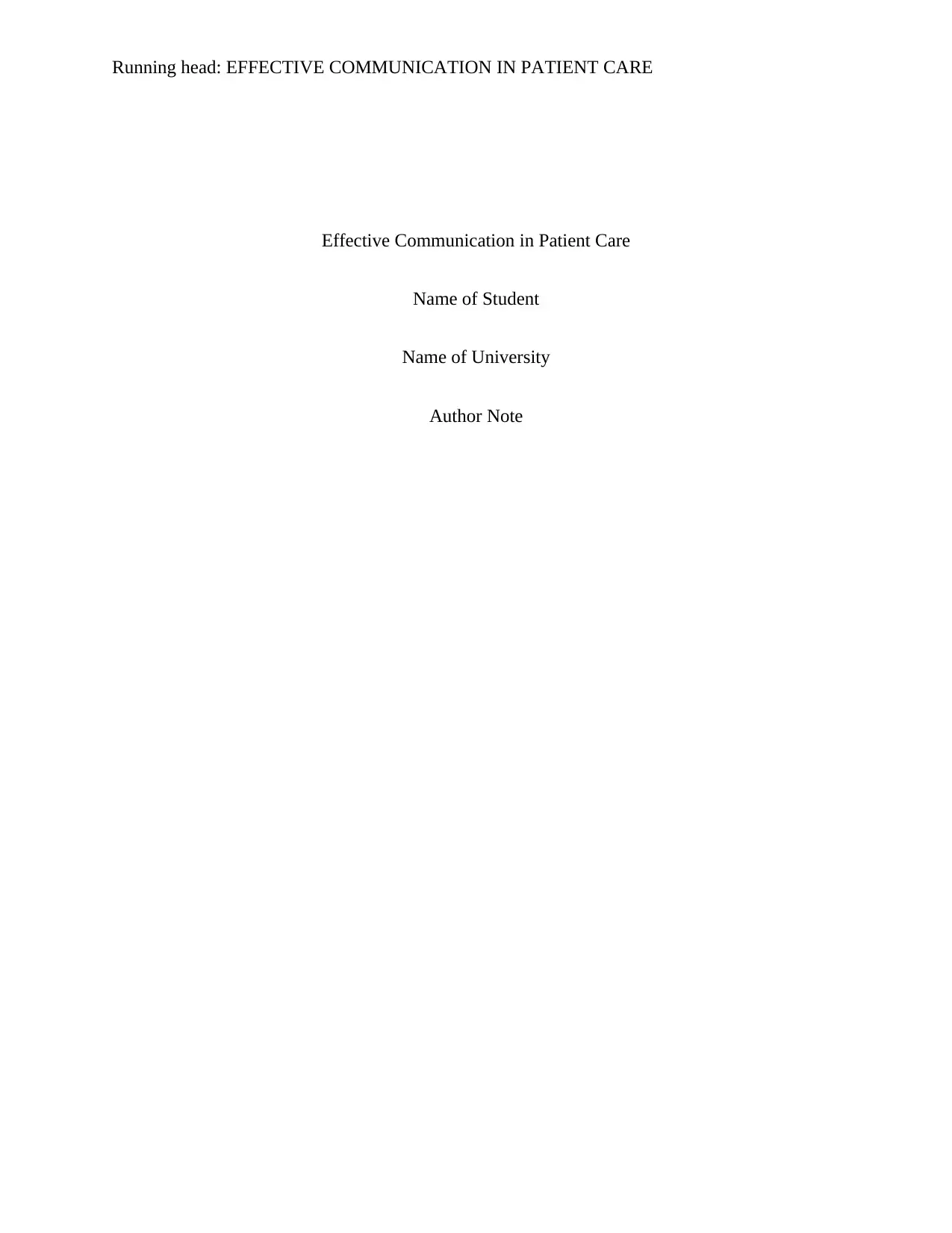
Running head: EFFECTIVE COMMUNICATION IN PATIENT CARE
Effective Communication in Patient Care
Name of Student
Name of University
Author Note
Effective Communication in Patient Care
Name of Student
Name of University
Author Note
Paraphrase This Document
Need a fresh take? Get an instant paraphrase of this document with our AI Paraphraser
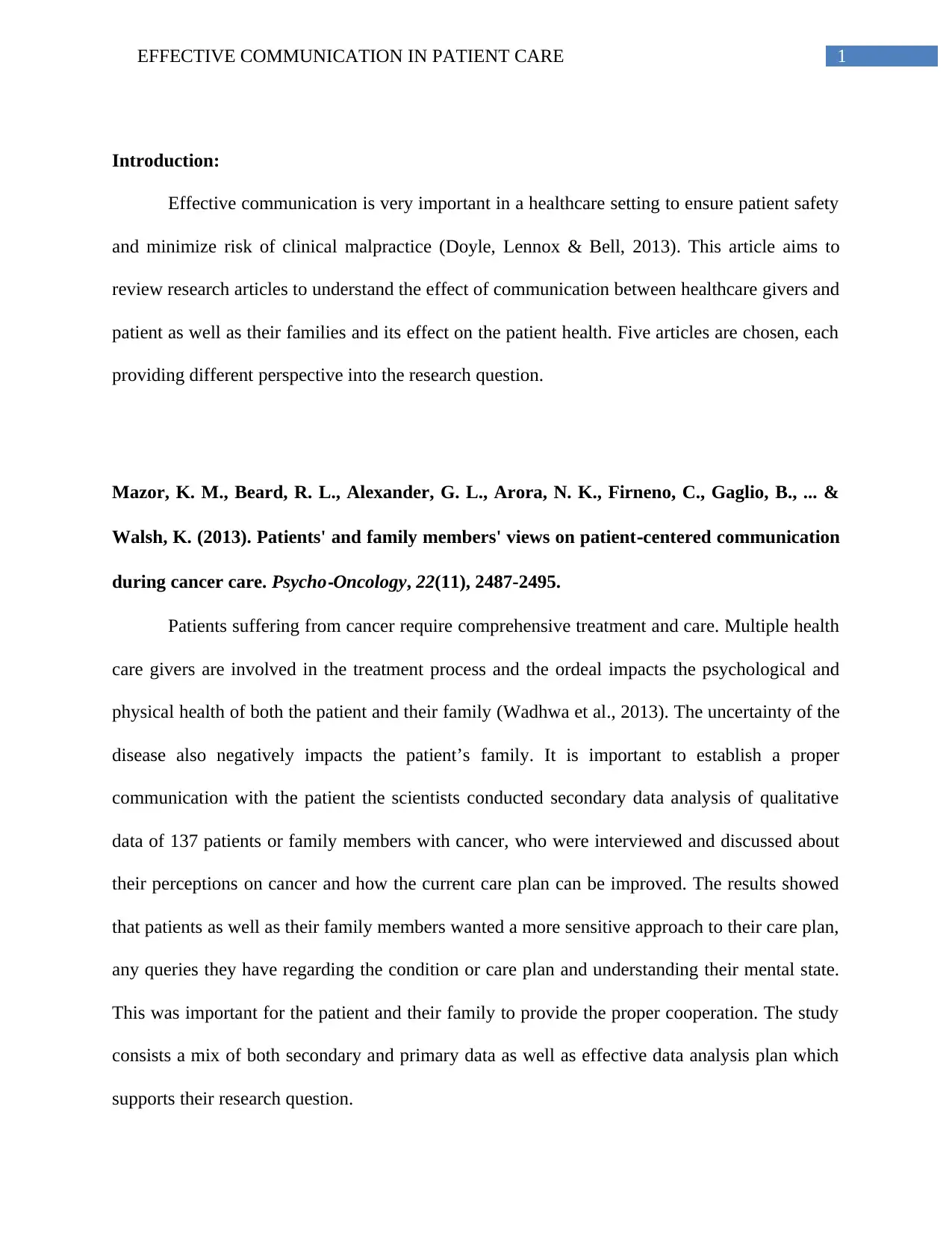
1EFFECTIVE COMMUNICATION IN PATIENT CARE
Introduction:
Effective communication is very important in a healthcare setting to ensure patient safety
and minimize risk of clinical malpractice (Doyle, Lennox & Bell, 2013). This article aims to
review research articles to understand the effect of communication between healthcare givers and
patient as well as their families and its effect on the patient health. Five articles are chosen, each
providing different perspective into the research question.
Mazor, K. M., Beard, R. L., Alexander, G. L., Arora, N. K., Firneno, C., Gaglio, B., ... &
Walsh, K. (2013). Patients' and family members' views on patient‐centered communication
during cancer care. Psycho
‐Oncology, 22(11), 2487-2495.
Patients suffering from cancer require comprehensive treatment and care. Multiple health
care givers are involved in the treatment process and the ordeal impacts the psychological and
physical health of both the patient and their family (Wadhwa et al., 2013). The uncertainty of the
disease also negatively impacts the patient’s family. It is important to establish a proper
communication with the patient the scientists conducted secondary data analysis of qualitative
data of 137 patients or family members with cancer, who were interviewed and discussed about
their perceptions on cancer and how the current care plan can be improved. The results showed
that patients as well as their family members wanted a more sensitive approach to their care plan,
any queries they have regarding the condition or care plan and understanding their mental state.
This was important for the patient and their family to provide the proper cooperation. The study
consists a mix of both secondary and primary data as well as effective data analysis plan which
supports their research question.
Introduction:
Effective communication is very important in a healthcare setting to ensure patient safety
and minimize risk of clinical malpractice (Doyle, Lennox & Bell, 2013). This article aims to
review research articles to understand the effect of communication between healthcare givers and
patient as well as their families and its effect on the patient health. Five articles are chosen, each
providing different perspective into the research question.
Mazor, K. M., Beard, R. L., Alexander, G. L., Arora, N. K., Firneno, C., Gaglio, B., ... &
Walsh, K. (2013). Patients' and family members' views on patient‐centered communication
during cancer care. Psycho
‐Oncology, 22(11), 2487-2495.
Patients suffering from cancer require comprehensive treatment and care. Multiple health
care givers are involved in the treatment process and the ordeal impacts the psychological and
physical health of both the patient and their family (Wadhwa et al., 2013). The uncertainty of the
disease also negatively impacts the patient’s family. It is important to establish a proper
communication with the patient the scientists conducted secondary data analysis of qualitative
data of 137 patients or family members with cancer, who were interviewed and discussed about
their perceptions on cancer and how the current care plan can be improved. The results showed
that patients as well as their family members wanted a more sensitive approach to their care plan,
any queries they have regarding the condition or care plan and understanding their mental state.
This was important for the patient and their family to provide the proper cooperation. The study
consists a mix of both secondary and primary data as well as effective data analysis plan which
supports their research question.
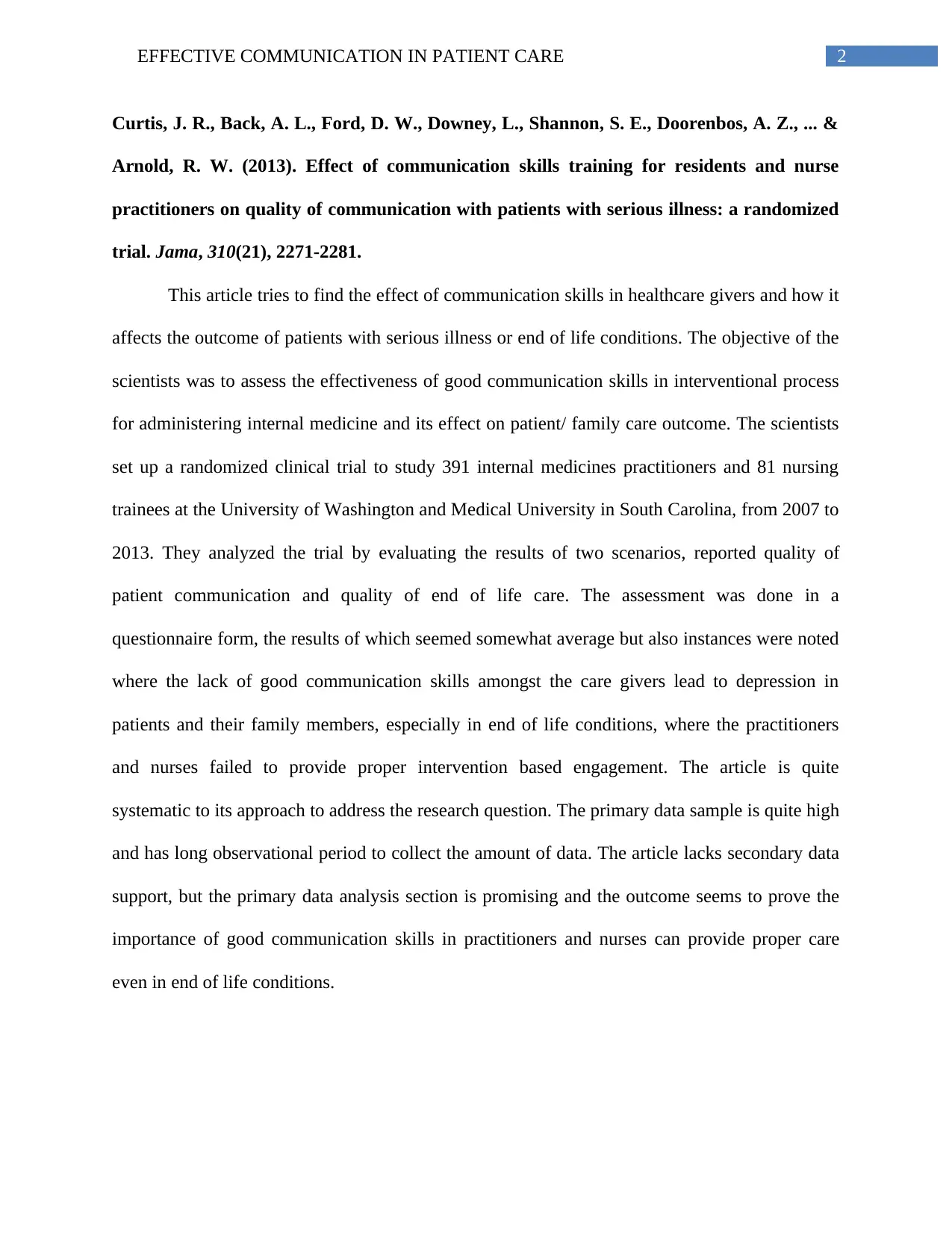
2EFFECTIVE COMMUNICATION IN PATIENT CARE
Curtis, J. R., Back, A. L., Ford, D. W., Downey, L., Shannon, S. E., Doorenbos, A. Z., ... &
Arnold, R. W. (2013). Effect of communication skills training for residents and nurse
practitioners on quality of communication with patients with serious illness: a randomized
trial. Jama, 310(21), 2271-2281.
This article tries to find the effect of communication skills in healthcare givers and how it
affects the outcome of patients with serious illness or end of life conditions. The objective of the
scientists was to assess the effectiveness of good communication skills in interventional process
for administering internal medicine and its effect on patient/ family care outcome. The scientists
set up a randomized clinical trial to study 391 internal medicines practitioners and 81 nursing
trainees at the University of Washington and Medical University in South Carolina, from 2007 to
2013. They analyzed the trial by evaluating the results of two scenarios, reported quality of
patient communication and quality of end of life care. The assessment was done in a
questionnaire form, the results of which seemed somewhat average but also instances were noted
where the lack of good communication skills amongst the care givers lead to depression in
patients and their family members, especially in end of life conditions, where the practitioners
and nurses failed to provide proper intervention based engagement. The article is quite
systematic to its approach to address the research question. The primary data sample is quite high
and has long observational period to collect the amount of data. The article lacks secondary data
support, but the primary data analysis section is promising and the outcome seems to prove the
importance of good communication skills in practitioners and nurses can provide proper care
even in end of life conditions.
Curtis, J. R., Back, A. L., Ford, D. W., Downey, L., Shannon, S. E., Doorenbos, A. Z., ... &
Arnold, R. W. (2013). Effect of communication skills training for residents and nurse
practitioners on quality of communication with patients with serious illness: a randomized
trial. Jama, 310(21), 2271-2281.
This article tries to find the effect of communication skills in healthcare givers and how it
affects the outcome of patients with serious illness or end of life conditions. The objective of the
scientists was to assess the effectiveness of good communication skills in interventional process
for administering internal medicine and its effect on patient/ family care outcome. The scientists
set up a randomized clinical trial to study 391 internal medicines practitioners and 81 nursing
trainees at the University of Washington and Medical University in South Carolina, from 2007 to
2013. They analyzed the trial by evaluating the results of two scenarios, reported quality of
patient communication and quality of end of life care. The assessment was done in a
questionnaire form, the results of which seemed somewhat average but also instances were noted
where the lack of good communication skills amongst the care givers lead to depression in
patients and their family members, especially in end of life conditions, where the practitioners
and nurses failed to provide proper intervention based engagement. The article is quite
systematic to its approach to address the research question. The primary data sample is quite high
and has long observational period to collect the amount of data. The article lacks secondary data
support, but the primary data analysis section is promising and the outcome seems to prove the
importance of good communication skills in practitioners and nurses can provide proper care
even in end of life conditions.
⊘ This is a preview!⊘
Do you want full access?
Subscribe today to unlock all pages.

Trusted by 1+ million students worldwide
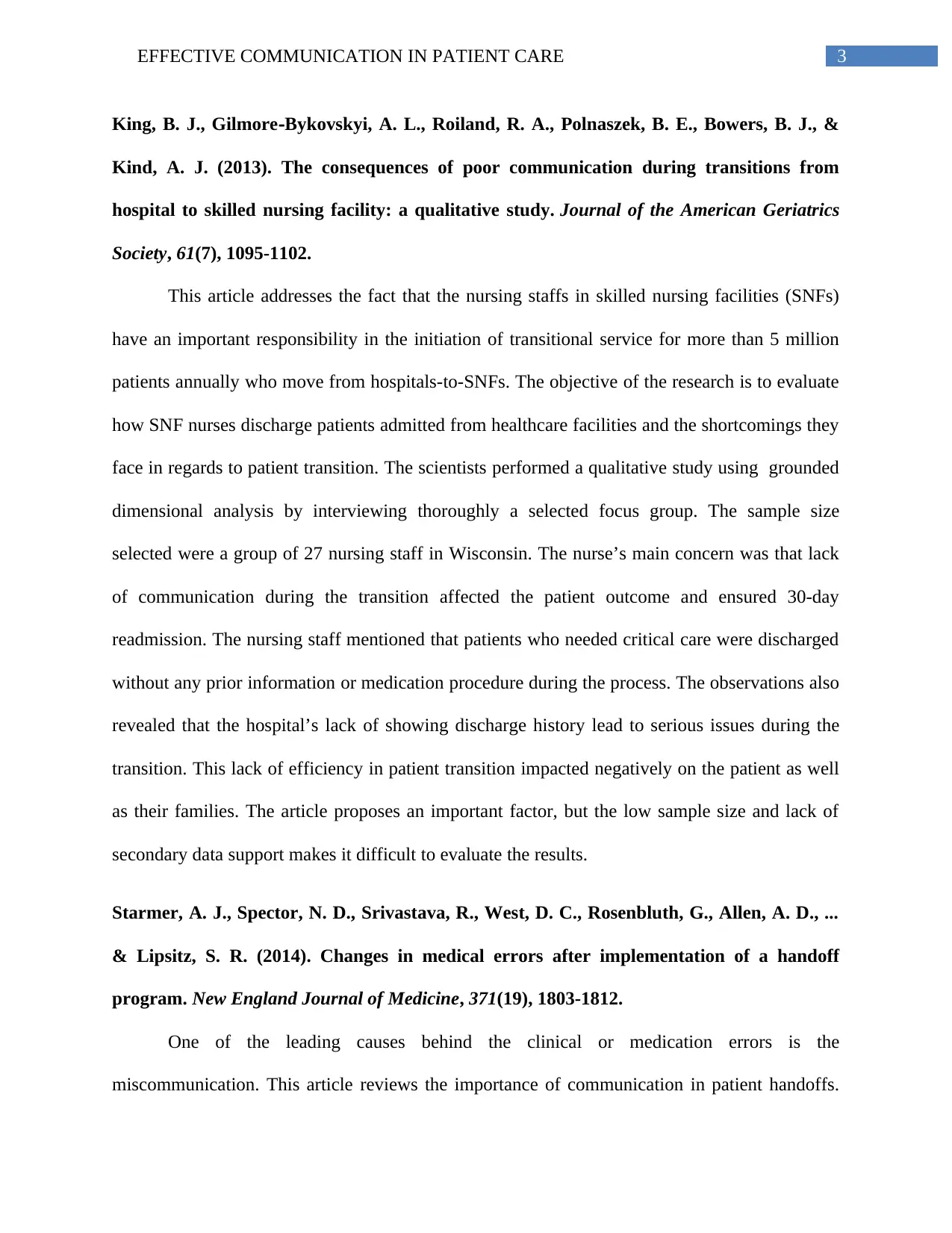
3EFFECTIVE COMMUNICATION IN PATIENT CARE
King, B. J., Gilmore‐Bykovskyi, A. L., Roiland, R. A., Polnaszek, B. E., Bowers, B. J., &
Kind, A. J. (2013). The consequences of poor communication during transitions from
hospital to skilled nursing facility: a qualitative study. Journal of the American Geriatrics
Society, 61(7), 1095-1102.
This article addresses the fact that the nursing staffs in skilled nursing facilities (SNFs)
have an important responsibility in the initiation of transitional service for more than 5 million
patients annually who move from hospitals-to-SNFs. The objective of the research is to evaluate
how SNF nurses discharge patients admitted from healthcare facilities and the shortcomings they
face in regards to patient transition. The scientists performed a qualitative study using grounded
dimensional analysis by interviewing thoroughly a selected focus group. The sample size
selected were a group of 27 nursing staff in Wisconsin. The nurse’s main concern was that lack
of communication during the transition affected the patient outcome and ensured 30-day
readmission. The nursing staff mentioned that patients who needed critical care were discharged
without any prior information or medication procedure during the process. The observations also
revealed that the hospital’s lack of showing discharge history lead to serious issues during the
transition. This lack of efficiency in patient transition impacted negatively on the patient as well
as their families. The article proposes an important factor, but the low sample size and lack of
secondary data support makes it difficult to evaluate the results.
Starmer, A. J., Spector, N. D., Srivastava, R., West, D. C., Rosenbluth, G., Allen, A. D., ...
& Lipsitz, S. R. (2014). Changes in medical errors after implementation of a handoff
program. New England Journal of Medicine, 371(19), 1803-1812.
One of the leading causes behind the clinical or medication errors is the
miscommunication. This article reviews the importance of communication in patient handoffs.
King, B. J., Gilmore‐Bykovskyi, A. L., Roiland, R. A., Polnaszek, B. E., Bowers, B. J., &
Kind, A. J. (2013). The consequences of poor communication during transitions from
hospital to skilled nursing facility: a qualitative study. Journal of the American Geriatrics
Society, 61(7), 1095-1102.
This article addresses the fact that the nursing staffs in skilled nursing facilities (SNFs)
have an important responsibility in the initiation of transitional service for more than 5 million
patients annually who move from hospitals-to-SNFs. The objective of the research is to evaluate
how SNF nurses discharge patients admitted from healthcare facilities and the shortcomings they
face in regards to patient transition. The scientists performed a qualitative study using grounded
dimensional analysis by interviewing thoroughly a selected focus group. The sample size
selected were a group of 27 nursing staff in Wisconsin. The nurse’s main concern was that lack
of communication during the transition affected the patient outcome and ensured 30-day
readmission. The nursing staff mentioned that patients who needed critical care were discharged
without any prior information or medication procedure during the process. The observations also
revealed that the hospital’s lack of showing discharge history lead to serious issues during the
transition. This lack of efficiency in patient transition impacted negatively on the patient as well
as their families. The article proposes an important factor, but the low sample size and lack of
secondary data support makes it difficult to evaluate the results.
Starmer, A. J., Spector, N. D., Srivastava, R., West, D. C., Rosenbluth, G., Allen, A. D., ...
& Lipsitz, S. R. (2014). Changes in medical errors after implementation of a handoff
program. New England Journal of Medicine, 371(19), 1803-1812.
One of the leading causes behind the clinical or medication errors is the
miscommunication. This article reviews the importance of communication in patient handoffs.
Paraphrase This Document
Need a fresh take? Get an instant paraphrase of this document with our AI Paraphraser
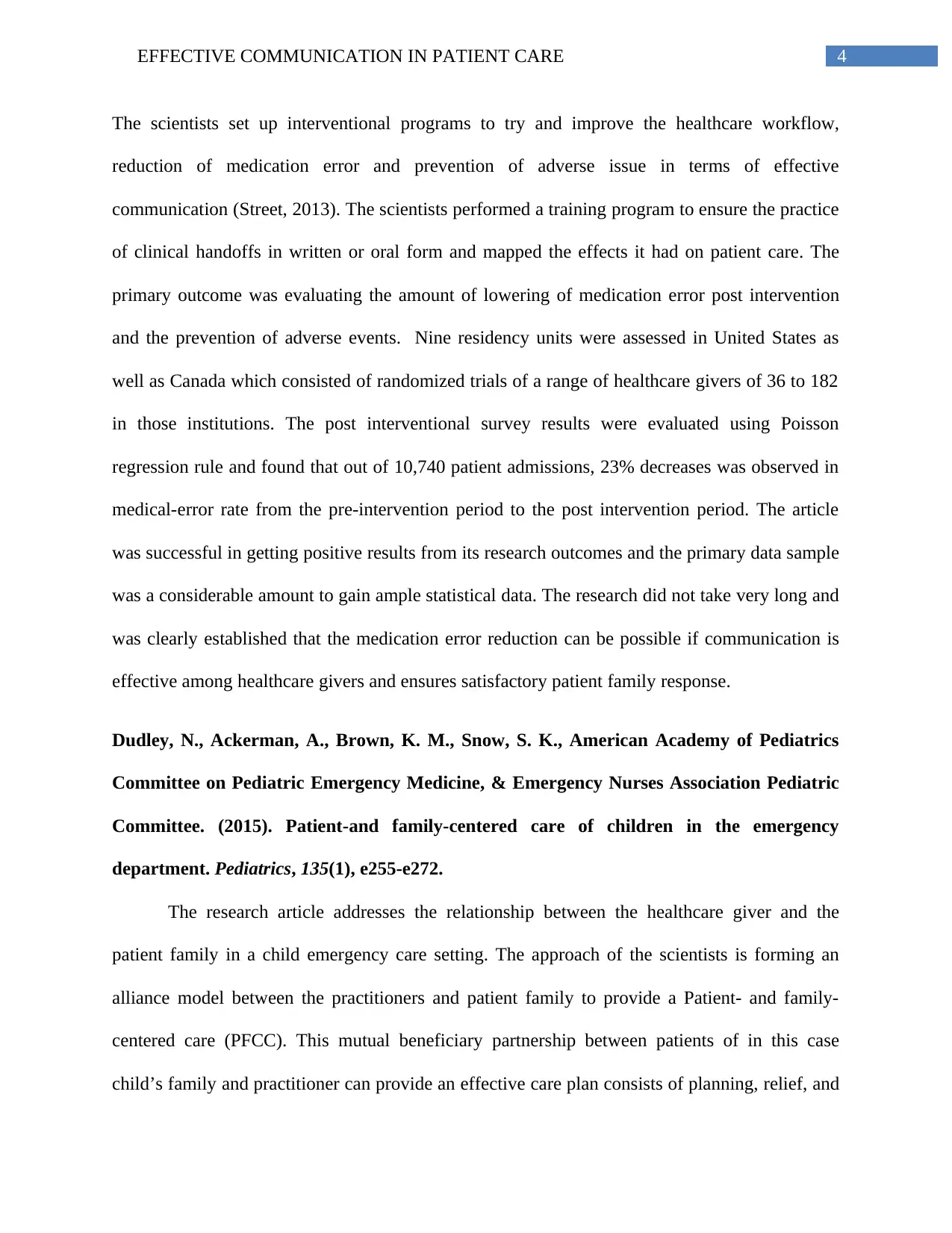
4EFFECTIVE COMMUNICATION IN PATIENT CARE
The scientists set up interventional programs to try and improve the healthcare workflow,
reduction of medication error and prevention of adverse issue in terms of effective
communication (Street, 2013). The scientists performed a training program to ensure the practice
of clinical handoffs in written or oral form and mapped the effects it had on patient care. The
primary outcome was evaluating the amount of lowering of medication error post intervention
and the prevention of adverse events. Nine residency units were assessed in United States as
well as Canada which consisted of randomized trials of a range of healthcare givers of 36 to 182
in those institutions. The post interventional survey results were evaluated using Poisson
regression rule and found that out of 10,740 patient admissions, 23% decreases was observed in
medical-error rate from the pre-intervention period to the post intervention period. The article
was successful in getting positive results from its research outcomes and the primary data sample
was a considerable amount to gain ample statistical data. The research did not take very long and
was clearly established that the medication error reduction can be possible if communication is
effective among healthcare givers and ensures satisfactory patient family response.
Dudley, N., Ackerman, A., Brown, K. M., Snow, S. K., American Academy of Pediatrics
Committee on Pediatric Emergency Medicine, & Emergency Nurses Association Pediatric
Committee. (2015). Patient-and family-centered care of children in the emergency
department. Pediatrics, 135(1), e255-e272.
The research article addresses the relationship between the healthcare giver and the
patient family in a child emergency care setting. The approach of the scientists is forming an
alliance model between the practitioners and patient family to provide a Patient- and family-
centered care (PFCC). This mutual beneficiary partnership between patients of in this case
child’s family and practitioner can provide an effective care plan consists of planning, relief, and
The scientists set up interventional programs to try and improve the healthcare workflow,
reduction of medication error and prevention of adverse issue in terms of effective
communication (Street, 2013). The scientists performed a training program to ensure the practice
of clinical handoffs in written or oral form and mapped the effects it had on patient care. The
primary outcome was evaluating the amount of lowering of medication error post intervention
and the prevention of adverse events. Nine residency units were assessed in United States as
well as Canada which consisted of randomized trials of a range of healthcare givers of 36 to 182
in those institutions. The post interventional survey results were evaluated using Poisson
regression rule and found that out of 10,740 patient admissions, 23% decreases was observed in
medical-error rate from the pre-intervention period to the post intervention period. The article
was successful in getting positive results from its research outcomes and the primary data sample
was a considerable amount to gain ample statistical data. The research did not take very long and
was clearly established that the medication error reduction can be possible if communication is
effective among healthcare givers and ensures satisfactory patient family response.
Dudley, N., Ackerman, A., Brown, K. M., Snow, S. K., American Academy of Pediatrics
Committee on Pediatric Emergency Medicine, & Emergency Nurses Association Pediatric
Committee. (2015). Patient-and family-centered care of children in the emergency
department. Pediatrics, 135(1), e255-e272.
The research article addresses the relationship between the healthcare giver and the
patient family in a child emergency care setting. The approach of the scientists is forming an
alliance model between the practitioners and patient family to provide a Patient- and family-
centered care (PFCC). This mutual beneficiary partnership between patients of in this case
child’s family and practitioner can provide an effective care plan consists of planning, relief, and
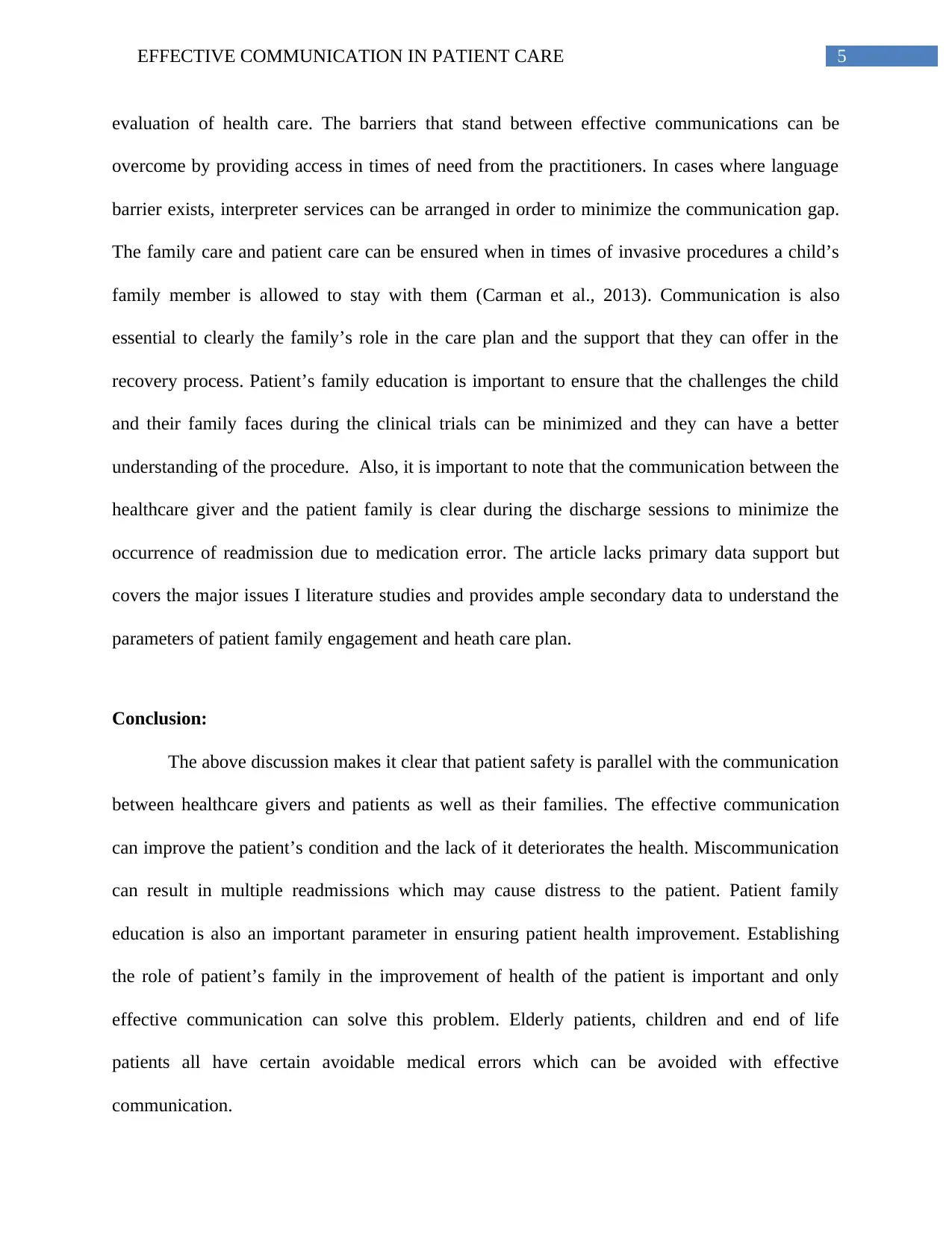
5EFFECTIVE COMMUNICATION IN PATIENT CARE
evaluation of health care. The barriers that stand between effective communications can be
overcome by providing access in times of need from the practitioners. In cases where language
barrier exists, interpreter services can be arranged in order to minimize the communication gap.
The family care and patient care can be ensured when in times of invasive procedures a child’s
family member is allowed to stay with them (Carman et al., 2013). Communication is also
essential to clearly the family’s role in the care plan and the support that they can offer in the
recovery process. Patient’s family education is important to ensure that the challenges the child
and their family faces during the clinical trials can be minimized and they can have a better
understanding of the procedure. Also, it is important to note that the communication between the
healthcare giver and the patient family is clear during the discharge sessions to minimize the
occurrence of readmission due to medication error. The article lacks primary data support but
covers the major issues I literature studies and provides ample secondary data to understand the
parameters of patient family engagement and heath care plan.
Conclusion:
The above discussion makes it clear that patient safety is parallel with the communication
between healthcare givers and patients as well as their families. The effective communication
can improve the patient’s condition and the lack of it deteriorates the health. Miscommunication
can result in multiple readmissions which may cause distress to the patient. Patient family
education is also an important parameter in ensuring patient health improvement. Establishing
the role of patient’s family in the improvement of health of the patient is important and only
effective communication can solve this problem. Elderly patients, children and end of life
patients all have certain avoidable medical errors which can be avoided with effective
communication.
evaluation of health care. The barriers that stand between effective communications can be
overcome by providing access in times of need from the practitioners. In cases where language
barrier exists, interpreter services can be arranged in order to minimize the communication gap.
The family care and patient care can be ensured when in times of invasive procedures a child’s
family member is allowed to stay with them (Carman et al., 2013). Communication is also
essential to clearly the family’s role in the care plan and the support that they can offer in the
recovery process. Patient’s family education is important to ensure that the challenges the child
and their family faces during the clinical trials can be minimized and they can have a better
understanding of the procedure. Also, it is important to note that the communication between the
healthcare giver and the patient family is clear during the discharge sessions to minimize the
occurrence of readmission due to medication error. The article lacks primary data support but
covers the major issues I literature studies and provides ample secondary data to understand the
parameters of patient family engagement and heath care plan.
Conclusion:
The above discussion makes it clear that patient safety is parallel with the communication
between healthcare givers and patients as well as their families. The effective communication
can improve the patient’s condition and the lack of it deteriorates the health. Miscommunication
can result in multiple readmissions which may cause distress to the patient. Patient family
education is also an important parameter in ensuring patient health improvement. Establishing
the role of patient’s family in the improvement of health of the patient is important and only
effective communication can solve this problem. Elderly patients, children and end of life
patients all have certain avoidable medical errors which can be avoided with effective
communication.
⊘ This is a preview!⊘
Do you want full access?
Subscribe today to unlock all pages.

Trusted by 1+ million students worldwide
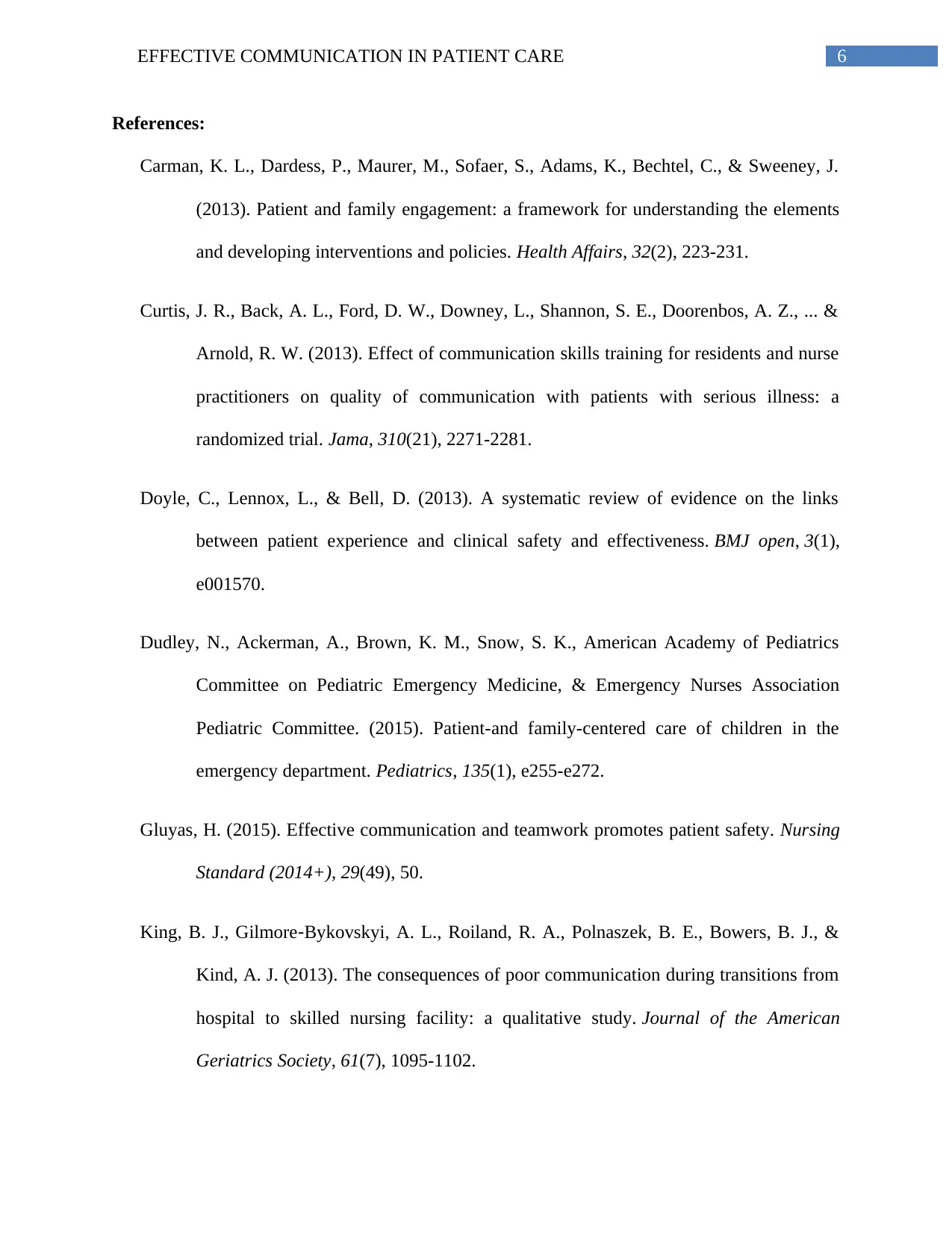
6EFFECTIVE COMMUNICATION IN PATIENT CARE
References:
Carman, K. L., Dardess, P., Maurer, M., Sofaer, S., Adams, K., Bechtel, C., & Sweeney, J.
(2013). Patient and family engagement: a framework for understanding the elements
and developing interventions and policies. Health Affairs, 32(2), 223-231.
Curtis, J. R., Back, A. L., Ford, D. W., Downey, L., Shannon, S. E., Doorenbos, A. Z., ... &
Arnold, R. W. (2013). Effect of communication skills training for residents and nurse
practitioners on quality of communication with patients with serious illness: a
randomized trial. Jama, 310(21), 2271-2281.
Doyle, C., Lennox, L., & Bell, D. (2013). A systematic review of evidence on the links
between patient experience and clinical safety and effectiveness. BMJ open, 3(1),
e001570.
Dudley, N., Ackerman, A., Brown, K. M., Snow, S. K., American Academy of Pediatrics
Committee on Pediatric Emergency Medicine, & Emergency Nurses Association
Pediatric Committee. (2015). Patient-and family-centered care of children in the
emergency department. Pediatrics, 135(1), e255-e272.
Gluyas, H. (2015). Effective communication and teamwork promotes patient safety. Nursing
Standard (2014+), 29(49), 50.
King, B. J., Gilmore‐Bykovskyi, A. L., Roiland, R. A., Polnaszek, B. E., Bowers, B. J., &
Kind, A. J. (2013). The consequences of poor communication during transitions from
hospital to skilled nursing facility: a qualitative study. Journal of the American
Geriatrics Society, 61(7), 1095-1102.
References:
Carman, K. L., Dardess, P., Maurer, M., Sofaer, S., Adams, K., Bechtel, C., & Sweeney, J.
(2013). Patient and family engagement: a framework for understanding the elements
and developing interventions and policies. Health Affairs, 32(2), 223-231.
Curtis, J. R., Back, A. L., Ford, D. W., Downey, L., Shannon, S. E., Doorenbos, A. Z., ... &
Arnold, R. W. (2013). Effect of communication skills training for residents and nurse
practitioners on quality of communication with patients with serious illness: a
randomized trial. Jama, 310(21), 2271-2281.
Doyle, C., Lennox, L., & Bell, D. (2013). A systematic review of evidence on the links
between patient experience and clinical safety and effectiveness. BMJ open, 3(1),
e001570.
Dudley, N., Ackerman, A., Brown, K. M., Snow, S. K., American Academy of Pediatrics
Committee on Pediatric Emergency Medicine, & Emergency Nurses Association
Pediatric Committee. (2015). Patient-and family-centered care of children in the
emergency department. Pediatrics, 135(1), e255-e272.
Gluyas, H. (2015). Effective communication and teamwork promotes patient safety. Nursing
Standard (2014+), 29(49), 50.
King, B. J., Gilmore‐Bykovskyi, A. L., Roiland, R. A., Polnaszek, B. E., Bowers, B. J., &
Kind, A. J. (2013). The consequences of poor communication during transitions from
hospital to skilled nursing facility: a qualitative study. Journal of the American
Geriatrics Society, 61(7), 1095-1102.
Paraphrase This Document
Need a fresh take? Get an instant paraphrase of this document with our AI Paraphraser
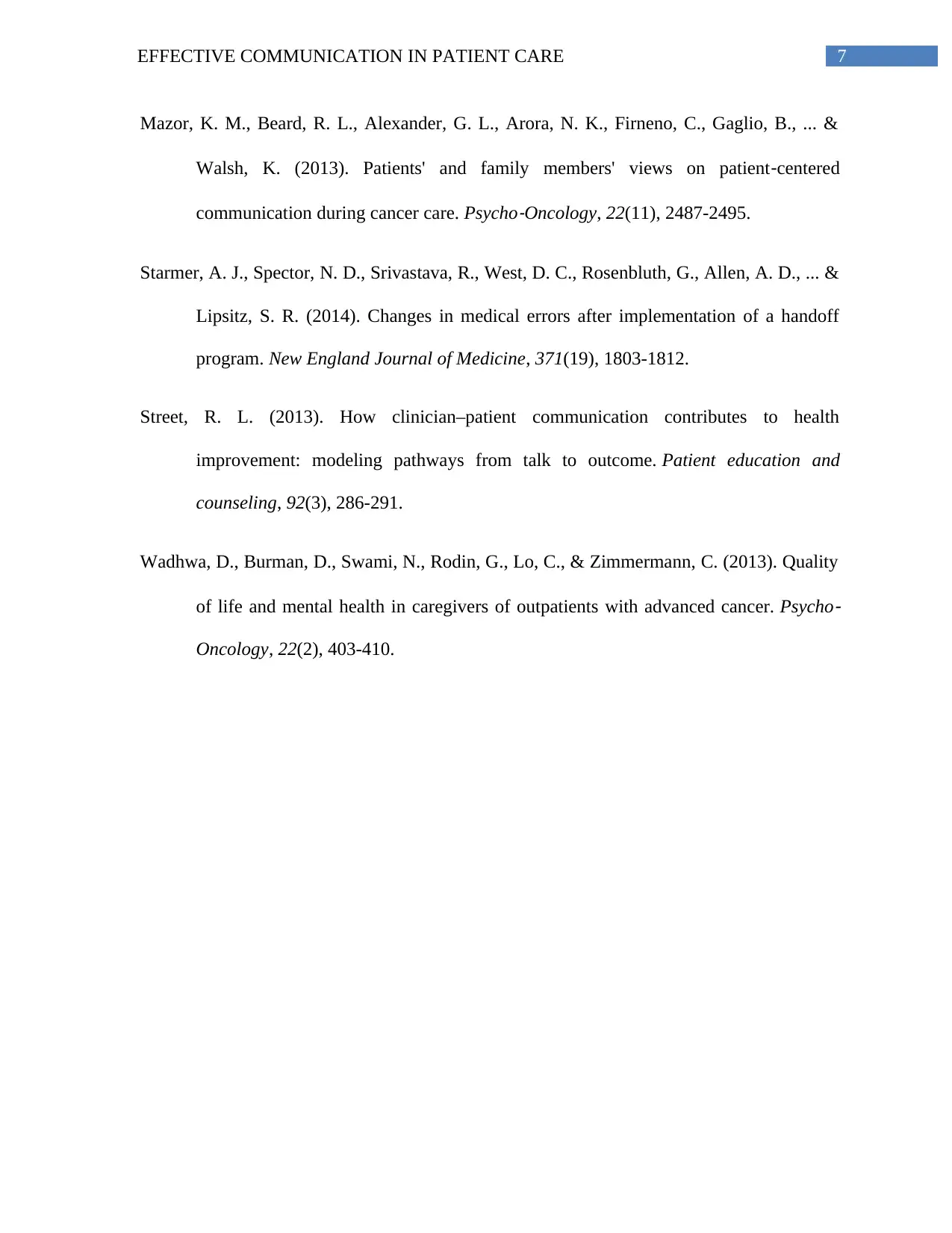
7EFFECTIVE COMMUNICATION IN PATIENT CARE
Mazor, K. M., Beard, R. L., Alexander, G. L., Arora, N. K., Firneno, C., Gaglio, B., ... &
Walsh, K. (2013). Patients' and family members' views on patient‐centered
communication during cancer care. Psycho
‐Oncology, 22(11), 2487-2495.
Starmer, A. J., Spector, N. D., Srivastava, R., West, D. C., Rosenbluth, G., Allen, A. D., ... &
Lipsitz, S. R. (2014). Changes in medical errors after implementation of a handoff
program. New England Journal of Medicine, 371(19), 1803-1812.
Street, R. L. (2013). How clinician–patient communication contributes to health
improvement: modeling pathways from talk to outcome. Patient education and
counseling, 92(3), 286-291.
Wadhwa, D., Burman, D., Swami, N., Rodin, G., Lo, C., & Zimmermann, C. (2013). Quality
of life and mental health in caregivers of outpatients with advanced cancer. Psycho
‐
Oncology, 22(2), 403-410.
Mazor, K. M., Beard, R. L., Alexander, G. L., Arora, N. K., Firneno, C., Gaglio, B., ... &
Walsh, K. (2013). Patients' and family members' views on patient‐centered
communication during cancer care. Psycho
‐Oncology, 22(11), 2487-2495.
Starmer, A. J., Spector, N. D., Srivastava, R., West, D. C., Rosenbluth, G., Allen, A. D., ... &
Lipsitz, S. R. (2014). Changes in medical errors after implementation of a handoff
program. New England Journal of Medicine, 371(19), 1803-1812.
Street, R. L. (2013). How clinician–patient communication contributes to health
improvement: modeling pathways from talk to outcome. Patient education and
counseling, 92(3), 286-291.
Wadhwa, D., Burman, D., Swami, N., Rodin, G., Lo, C., & Zimmermann, C. (2013). Quality
of life and mental health in caregivers of outpatients with advanced cancer. Psycho
‐
Oncology, 22(2), 403-410.
1 out of 8
Related Documents
Your All-in-One AI-Powered Toolkit for Academic Success.
+13062052269
info@desklib.com
Available 24*7 on WhatsApp / Email
![[object Object]](/_next/static/media/star-bottom.7253800d.svg)
Unlock your academic potential
Copyright © 2020–2025 A2Z Services. All Rights Reserved. Developed and managed by ZUCOL.





